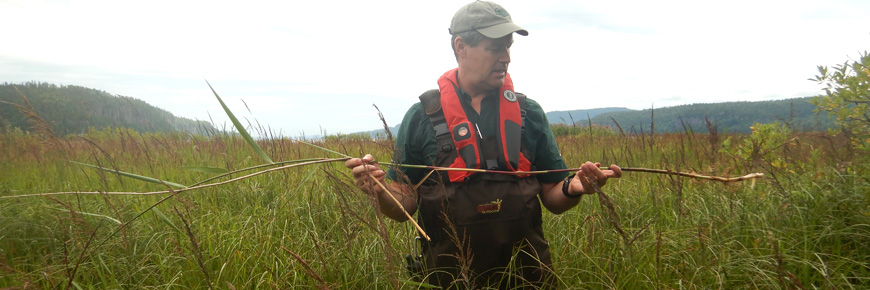
Phragmites
Lake Superior National Marine Conservation Area
The European Common Reed (Phragmites australis subsp. australis), commonly known as invasive phragmites, is a wetland plant native to Eurasia which can now be found throughout much of Ontario. It is a tall (2-6 metres) perennial grass that grows in moist soil or shallow waters in wetlands, streambanks, lakeshores, wet fields and ditches. Phragmites can spread very aggressively by seed or underground rhizomes, and plant fragments carried by water or wind can also regenerate easily. The dense stands formed by this species provide little value for wildlife, can displace native wetland vegetation and threaten habitats of wetland species, including species at risk. Elimination of invasive phragmites from the Lake Superior basin is a priority action identified in the Lake Superior Lakewide Action and Management Plan (Lake Superior Partnership 2016).
To complicate matters, there is also a native variety of phragmites (Phragmites australis subsp. americanus), which does not seem to take over and dominate wetland habitats like the invasive type does. Resource Conservation staff discovered and investigated occurrences of phragmites along the Trans-Canada Highway (outside of Lake Superior NMCA boundaries), as well as an area of the Nipigon River marsh, just on the edge of Lake Superior NMCA boundaries. Most sites along the highway were identified as invasive phragmites, although one stand was the native variety. The occurrence along Nipigon River was also identified as native phragmites.
To further understanding of the potential distribution of phragmites in Lake Superior NMCA, staff chartered a helicopter flight on October 13, 2017. This aerial survey examined the mainland shoreline of the conservation area from the western boundary at Thunder Cape almost to the eastern boundary of Bottle Point near Terrace Bay; the one section of mainland not overflown was the southern Black Bay Peninsula, which was considered less at risk of colonization by phragmites because of the lack of highway or rail transportation corridors, which appear to be the primary vector for range expansion of the species. No evidence of invasive phragmites was found within the Lake Superior NMCA on this survey.
These occurrences of non-native, invasive variety of phragmites in this region are of concern; once established, phragmites is very difficult to control or eradicate. The closest site to the NMCA boundary is the Coughlin Road site, approximately 6 km from the Black Bay shoreline. This site is also only a few kilometres from the provincially significant wetlands on the Black Bay Peninsula. In wetland areas of southern Ontario, such as the Long Point area, large scale and very expensive efforts are underway to control this plant. Early control of new occurrences is the most efficient and cost-effective approach, and the possibility of control measures in this area will be investigated.
- Date modified :